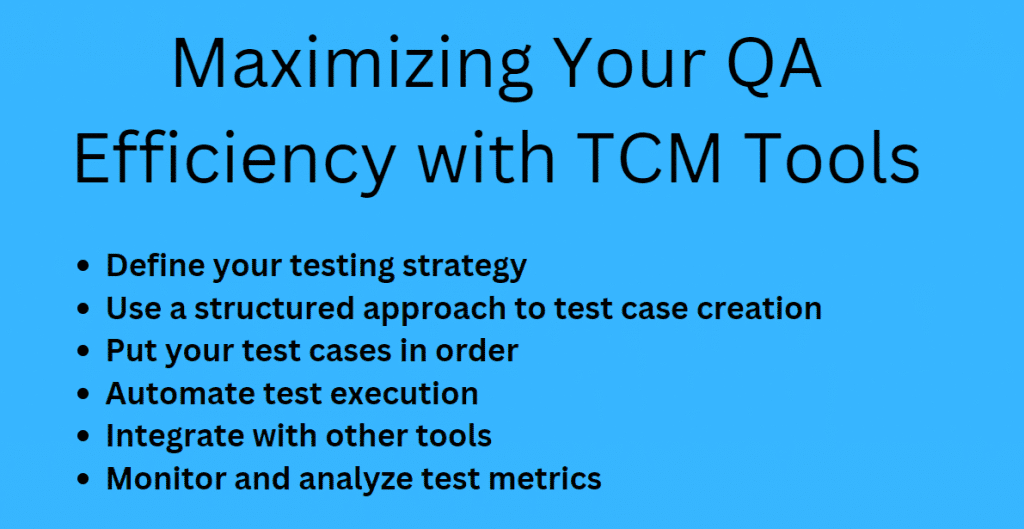In the field of software development, Quality Assurance (QA) is a critical aspect of the development lifecycle. QA teams are responsible for ensuring that the software product meets the customer’s requirements, is reliable, and performs as expected. The QA process involves multiple activities, including creating test cases, executing tests, reporting and tracking defects, and verifying fixes. To streamline and optimize these activities, QA teams use Test Case Management (TCM) tools. In this blog, we will explore how TCM tools can help maximize your QA efficiency.
What is Test Case Management?
Test Case Management is the process of managing all the activities related to test cases. This includes creating test cases, grouping them into test suites, executing tests, reporting defects, and tracking them until they are resolved. The purpose of TCM is to ensure that the testing process is efficient, organized, and streamlined.
What are Test Case Management Tools?
Test Case Management tools are software applications designed to manage the entire testing process, including test case creation, execution, and reporting. These tools typically provide a user-friendly interface for creating and organizing test cases, executing tests, and reporting defects. TCM tools can integrate with other tools in the development ecosystem, such as bug tracking systems and Continuous Integration/Continuous Delivery (CI/CD) tools.
Benefits of Using TCM Tools
Using TCM tools can bring a variety of benefits to your QA process, including:
- Increased efficiency: TCM tools can automate many tasks related to the testing process, such as creating test cases, executing tests, and generating reports. This automation saves time and lowers the chance of human error.
- Improved collaboration: TCM tools can help promote collaboration between team members, as all the information related to testing is stored in a central location. This results in better communication and reduces the risk of miscommunication.
- Better organization: TCM tools provide a structured and organized approach to managing test cases. This helps ensure that all the necessary tests are performed, and that no critical areas are overlooked.
- Increased test coverage: TCM tools can help you ensure that all the critical areas of the application are covered by tests. This can help reduce the risk of defects in production.
- Better tracking and reporting: TCM tools provide detailed reports on the testing process, including test execution results and defect reports. This information can be used to point out areas for improvement and to track progress over time.
Features to Look for in TCM Tools
When selecting a TCM tool, there are several features you should look for. These include:
- Test case creation: The tool should provide a user-friendly interface for creating test cases. It should allow you to specify the test steps, expected results, and any preconditions or postconditions.
- Test case organization: The tool should allow you to group test cases into test suites, making it easy to manage and execute multiple tests.
- Test execution: The tool should provide a way to execute tests, either manually or automatically. It must also offer a means of monitoring the outcomes of test execution.
- Defect reporting: The tool should provide a way to report defects, including detailed information about the defect and the steps to reproduce it.
- Integration with other tools: The tool should integrate with other tools in your development ecosystem, such as bug tracking systems and CI/CD tools.
Examples of TCM Tools
TCM tools are widely available, and each has a unique set of features and functionalities. Here are some of the most popular TCM tools:
- Kualitee: Kualitee is a test management tool that originated to help software development teams manage their testing efforts more efficiently. It provides a centralized platform for creating, executing, and managing test cases and test plans, as well as for tracking defects and issues.
- TestRail: TestRail is a web-based test management tool that allows you to create, manage, and organize test cases. It provides a user-friendly interface for test case creation, test execution, and defect reporting. TestRail also integrates with other tools in the development ecosystem, such as Jira, Bugzilla, and Jenkins.
- qTest: qTest is a test management tool that allows you to manage all aspects of the testing process, from test case creation to defect tracking. qTest also provides real-time test metrics and integrates with other tools, such as Jira and Selenium.
- PractiTest: PractiTest is a test management tool that allows you to manage test cases, requirements, and defects in one place. It provides a user-friendly interface for test case creation, test execution, and defect reporting. PractiTest also integrates with other tools, such as Jira, Jenkins, and Salesforce.
Maximizing Your QA Efficiency with TCM Tools

To maximize your QA efficiency with TCM tools, here are some best practices you should follow:
- Define your testing strategy: Before you start using a TCM tool, define your testing strategy. This should include defining your testing objectives, identifying the critical areas of the application, and determining the testing approach.
- Use a structured approach to test case creation: When creating test cases, use a structured approach. This should include specifying the test steps, expected results, and any preconditions or postconditions. Your test cases will be consistent and simple to understand as a result.
- Put your test cases in order: Based on the essential aspects of the application, group your test cases into test suites. Test management and execution will be made simpler as a result.
- Automate test execution: Whenever possible, use software like Selenium or Appium to automate test execution. Time will be saved, and the risk of human error is decreased.
- Integrate with other tools: Integrate your TCM tool with other tools in your development ecosystem, such as bug tracking systems and CI/CD tools. This will streamline the testing process and improve collaboration between team members.
- Monitor and analyze test metrics: Use the test metrics provided by your TCM tool to monitor the progress of testing and identify areas for improvement. This will help you optimize your testing process over time.
Conclusion
Test Case Management tools are essential for maximizing your QA efficiency. They offer a methodical and structured way to manage test cases, run tests, and report flaws. TCM tools can automate many tasks related to the testing process, saving time and reducing the risk of human error. To get the most out of your TCM tool, follow best practices such as defining your testing strategy, using a structured approach to test case creation, and integrating with other tools in your development ecosystem. By implementing these practices, you can streamline your testing procedure and provide your clients with software that is of the finest quality.















































